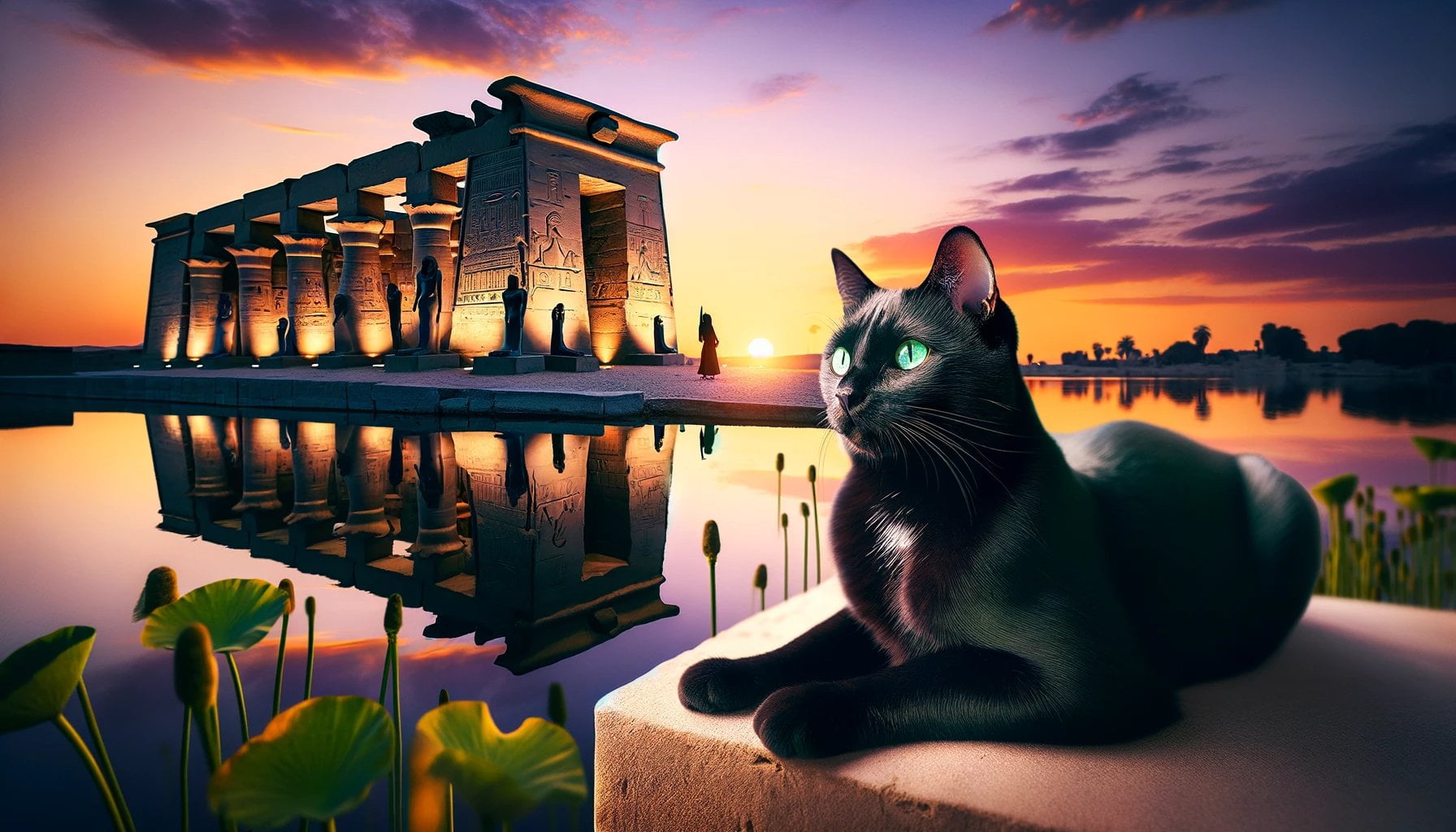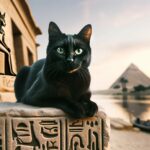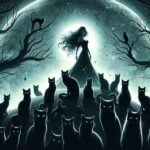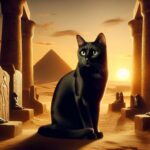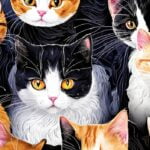Delve into the mystical realm of the ancient Egyptian goddess Bastet and unravel the enigmatic connection between black cats and this revered deity. In this captivating article, we explore the rich history and significance behind the Bastet black cat, delving into the meaning and symbolism associated with these feline companions. Join us on a journey through Egyptian folklore and mythology as we unearth the secrets of Bastet and her enduring bond with black cats. Discover the fascinating world of Bastet, the festival dedicated to her, and the profound impact she has had on ancient and modern cultures alike.

Key Takeaways:
- The ancient Egyptians worshipped the goddess Bastet, who was depicted as a woman with the head of a black cat.
- Black cats were revered as the embodiment of Bastet and killing one was believed to bring a death sentence.
- Bastet was the goddess of cats, music, women, childbirth, and pleasure, and she protected women and crops.
- Initially associated with lionesses, Bastet later became connected with housecats.
- Images of Bastet were often carved of alabaster and she was often depicted holding a sistrum decorated with cats and an aegis decorated with a collar or lioness head.
- Bastet had a wide range of attributes and aspects.
- The town of Bubastis, where Bastet’s religious sect was centered, carried her name, which means “House of Bastet.”
- In ancient Greek religion, Bastet is known as Ailuros.
The Enigmatic Bastet: Unraveling the Mystical Connection Between Black Cats and the Ancient Egyptian Goddess
The Legend of Bastet and the Symbolic Black Cat
Have you ever wondered why black cats have been associated with magic and mystery throughout history? It turns out that these enigmatic felines have deep roots in ancient mythology, particularly in the fascinating world of the ancient Egyptian goddess Bastet. In this article, we will embark on a journey to unravel the mystical connection between black cats and the captivating deity that inspired their symbolism.
The Goddess Bastet and Her Divine Domains
In ancient Egypt, the goddess Bastet held a prominent place in the pantheon. Often depicted as a woman with the head of a black cat, she embodied a wide range of attributes and aspects. Bastet was not just a goddess of cats but also had dominion over music, women, childbirth, and pleasure.
Her influence extended beyond the spiritual realm, as she was believed to protect women and crops. Worshippers would seek her favor, particularly in Bubastis, the city in Lower Egypt that carried her name, meaning “House of Bastet.”
The Divine Transformation: Lioness to Housecat
Interestingly, Bastet’s depiction as a woman with a black cat’s head was not her original form. In earlier times, she was represented as a fierce lioness goddess, known for her strength and ferocity. It was only later that she became associated with housecats, highlighting her transition as a goddess who catered to the domestic sphere.
The Sacred Symbols of Bastet and the Revered Black Cat
To further understand the connection between Bastet and black cats, we must explore the symbols associated with the goddess. In many artistic representations, Bastet is seen holding a sistrum decorated with cats, symbolizing her role as the goddess of music and pleasure.
Moreover, she is often adorned with an aegis decorated with a collar or a lioness head, paying homage to her earlier form. These symbols serve as a reminder of her power and influence, as well as the mystical connection she shares with the black cats that were believed to be her earthly manifestations.
The Reverence and Protection of Black Cats in Ancient Egypt
The ancient Egyptians held black cats in utmost reverence due to their association with Bastet. To harm or kill a black cat was considered a grave offense and believed to bring forth a death sentence. This veneration of black cats further emphasizes the deep bond between these felines and the mystical goddess they represented.
The Legacy of Bastet and Black Cats Today
While the ancient Egyptian civilization may have faded into history, the allure of Bastet and black cats continues to captivate the modern world. Black cats are still viewed as mysterious and often associated with magic and witchcraft, thanks to the enduring legacy of Bastet.
Whether you adore black cats for their striking appearance or appreciate the mysticism surrounding them, the symbolic connection to the ancient Egyptian goddess Bastet adds an intriguing layer to their charm. So, the next time a black cat crosses your path, take a moment to appreciate the mystical bond they share with the enigmatic Bastet.
Table: Depictions of Bastet Throughout History
| Image | Description |
|---|---|
| Woman with Black Cat Head | Representing Bastet’s later form, showcasing her connection with housecats. |
| Lioness Goddess | Depicting Bastet’s earlier form, symbolizing strength and ferocity. |
| Sistrum Decorated with Cats | Highlighting Bastet’s association with music and pleasure. |
| Aegis Decorated with Collar | Reminding us of Bastet’s power and her connection with lions. |
As we delve into the mythological realm of Bastet and the symbolic black cat, we can’t help but be enthralled by the profound cultural significance intertwined with these mystical creatures. Their allure and connection to the ancient goddess continue to spark our curiosity and imagination, ensuring that the legacy of Bastet and black cats will remain eternally captivating.
Bastet, known as the Egyptian goddess of home, fertility, and protection, was often depicted as a black cat. Curious about the significance of her feline companion? Learn more about “Was Bastet a black cat?” by clicking here.
Unveil the mystery behind Bastet’s color symbolism by exploring “Why is Bastet a black cat?” Click here to delve into the intriguing world of ancient Egyptian beliefs.
Discover the enchanting story of Bastet, the goddess of black cats. Unravel the secrets surrounding her sacred role by clicking here.
Who is Bastet?
Bastet, also known as Bast, is an ancient Egyptian goddess who holds a special place in the hearts and minds of those fascinated by the mystical world. As a seasoned journalist with a passion for the supernatural, I have delved deep into the rich history and significance of Bastet and her connection with black cats. Allow me to take you on a journey into the enigmatic realm of the Egyptian goddess and her feline companions.
Origins and Representation
Bastet’s origins can be traced back to the Second Dynasty of ancient Egypt, around 2890 BCE. In the early depictions, she was often portrayed as a powerful lioness or a lion-headed woman. However, as Egyptian society underwent changes, so did the representation of Bastet. Gradually, she transformed into a domestic cat, aligning with the shifts in Egyptian culture and ideology.
Significance and Powers
Ancient Egyptian culture attributed great significance to Bastet, considering her one of the most revered deities in their pantheon. She embodied various aspects, including protection, fertility, music, women, childbirth, and pleasure. As a goddess of protection, Bastet garnered devotion for her nurturing and shielding qualities, often symbolized as a vigilant guardian.
Worship and Symbols
The worship of Bastet took place through intricate rituals and ceremonies. Temples dedicated to her were built, with the most renowned one situated in the city of Bubastis. This city became a hub for her worship, attracting pilgrims from far and wide who would participate in festivals honoring the goddess.
When it comes to symbols, Bastet was commonly depicted as a cat-headed goddess or as a black cat. Her other symbols included a lioness, a domestic cat, an ointment jar, a sistrum (a musical instrument), and a solar disk. The reverence for cats in ancient Egyptian culture, especially black cats, stemmed from their association with Bastet.
Parentage and Beliefs
Different myths and beliefs offer varying accounts of Bastet’s parentage. Some associate her as the daughter of the sun god Ra, while others connect her with the god Ptah. The diverse interpretations highlight the complexity of ancient Egyptian mythology and the various lenses through which deities were understood.
The Sacred Status of Cats
The connection between Bastet and cats was so profound that injuring or killing a cat was considered an offense and an insult to the goddess herself. In ancient Egypt, accidental or intentional harm to a cat could result in the death penalty. Cats held a sacred status within society, with the belief that Bastet could manifest in any living cat in Egypt.
Bastet, with her protective and nurturing qualities, remains an iconic figure in Egyptian mythology. The evolution of her representation, from a fierce lioness to a domestic cat, mirrors the cultural and societal dynamics of ancient Egypt.
Key Takeaways:
- Bastet, an ancient Egyptian goddess, is closely associated with cats, especially black cats.
- She transitioned from being depicted as a lioness goddess to a domestic cat, reflecting shifts in Egyptian society.
- Bastet held great significance in Egyptian culture and was revered for her protective and nurturing qualities.
- Worshippers engaged in rituals and ceremonies at temples dedicated to Bastet, with the city of Bubastis being a prominent center of worship.
- Cats, particularly black cats, were considered sacred due to their association with Bastet, and harming them was a grave offense.
- The parentage of Bastet varied in different myths and beliefs, highlighting the diverse interpretations of ancient Egyptian deities.
Sources:
- Bastet: Ancient Egypt’s Most Important Cat Goddess – History Cooperative
- Cats, Bastet, and the Worship of Feline Goddesses in Ancient Egypt – The American Research Center in Egypt (ARCE)
The Festival of Bastet
With its origins rooted in ancient Egyptian mythology, the festival of Bastet holds a place of significance and intrigue. This annual event serves as a celebration of the goddess Bastet, a revered figure who evolved from a war goddess to a symbol of protection and motherhood. Deeply ingrained in the cultural fabric of ancient Egypt, this festival attracted hundreds of thousands of worshippers who sought to honor and pay homage to the goddess.
Appearance and Evolution of Bastet
Bastet’s journey through Egyptian mythology took a fascinating turn when her image transformed from being portrayed as a lioness or a woman with a lioness’ head to a domestic cat or a cat-headed woman. This shift in representation occurred during the Third Intermediate Period of Egypt and became more prevalent during the New Kingdom and subsequent eras.
Bastet’s Role and Attributes
Bastet’s significance extended beyond her association with cats. She embodied various aspects such as protection, domesticity, women, childbirth, music, and pleasure. Worshippers sought her favor in protecting mothers and their newborn children. Additionally, Bastet was associated with ointments and protective rituals performed by the ancient Egyptians.
The Festival of Bastet
Attracting as many as half a million people, the festival of Bastet was a grand event that left an indelible mark on ancient Egyptian culture. Those who embarked on this journey participated in a series of enchanting ceremonies and rituals. Singing and dancing filled the air, adding to the vibrant atmosphere of the festival. The festivities included sacrificial rituals dedicated to Bastet, allowing worshippers to express their devotion and seek blessings from the goddess.
Ancient Egyptians traveled in droves, some 700,000 strong, down the Nile to the port city of Bubastis, where the festival took place. The elaborate rituals, extravagant ceremonies, and enchanting songs were all dedicated to the goddess Bastet, symbolizing the profound connection between her and her worshippers.
The Significance of Cats in Bastet’s Worship
In the ancient Egyptian culture, cats held a sacred status due to their association with Bastet. Considered personifications of the goddess herself, injuring or killing a cat was considered a grave insult to Bastet. The accidental or intentional death of a cat was even punishable by death in ancient Egypt. This reverence and protection extended to black cats, adding to their allure and mystique.
Cited Sources:
– World History Encyclopedia
– Egyptian History
Key Takeaways:
- The festival of Bastet was an annual event dedicated to honoring the goddess Bastet, an important figure in ancient Egyptian mythology.
- Bastet’s image evolved from a lioness or a woman with a lioness’ head to a domestic cat or a cat-headed woman.
- The festival attracted hundreds of thousands of worshippers who participated in singing, dancing, and sacrificial rituals.
- Bastet’s association with cats, including black cats, held deep significance in ancient Egyptian culture.
- Harming or killing a cat, especially a black cat, was considered a grave offense punishable by death.
Cited Sources:
1. World History Encyclopedia
2. Egyptian History

FAQ
Q1: What is the significance of black cats in Egyptian mythology?
A1: Black cats were believed to be the embodiment of the goddess Bastet, who was worshipped in ancient Egypt. They were seen as sacred and revered throughout the community.
Q2: What were the powers and attributes associated with the goddess Bastet?
A2: Bastet was associated with various aspects such as protection, fertility, music, women, childbirth, and pleasure. She was revered for her nurturing and shielding qualities.
Q3: How did the worship of Bastet take place in ancient Egypt?
A3: Temples dedicated to Bastet were built, with the most famous being the Temple of Bastet in the city of Bubastis. The annual festival of Bastet attracted a large number of worshippers who participated in rituals, sacrifices, and songs dedicated to the goddess.
Q4: What were the consequences of harming a cat in ancient Egypt?
A4: Injuring or killing a cat, especially a black cat associated with Bastet, was considered a grave offense and insult to the goddess. Accidental or intentional harm to a cat was punishable by the death penalty.
Q5: Who was Bastet and how did her representation evolve over time?
A5: Bastet, also known as Bast, was an ancient Egyptian goddess initially depicted as a lioness or a lion-headed woman. However, her representation gradually changed to that of a domestic cat or a cat-headed woman. This evolution reflected the shifting cultural and societal dynamics of ancient Egypt.
- Mastering Leader in Spanish: The Complete Guide - April 19, 2025
- Uncovering Surprising Parallels: England Size Compared to US States - April 19, 2025
- Old Mexico Map: Border Shifts 1821-1857 - April 19, 2025
